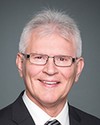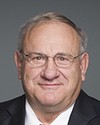Madam Speaker, I am glad to share this time with my hon. colleague, the member for Portneuf—Jacques-Cartier.
As vice-chair of the Standing Committee on Environment and Sustainable Development, I am pleased to stand in this House to speak to Bill C-18.
I was away last week, but last week in the House during debate on Bill C-18, there seemed to be some debate as to who had the most beautiful scenery in their riding. I am here to settle that. It is mine, Yellowhead, and the majestic Jasper National Park. Sorry, but those guys all lose.
Canadians and visitors to my riding of Yellowhead can experience nature and develop personal connections to the park. Jasper has something for everyone, whether a novice or an adventure enthusiast. In fact, there is Maligne Canyon, a stunning, deep limestone gorge full of waterfalls, fossils, and lush plant life. It can be explored from above in the summer and from below in the winter, where people can walk along the ice. It hosts over 400,000 visitors a year.
There are 75 kilometres of cross-country skiing and over 200 kilometres of official trails surrounding Jasper townsite, which are perfect for fat biking, winter walking, and snowshoeing during this time of year. For those who do not know what a fat bike is, it is that new modern bike that has tires close to four inches in size on wider rims. The bike is designed for low ground pressure, allowing for riding on soft, unstable terrain, such as snow, sand, bogs, and stuff like that. There are a lot of fat bikes around Jasper. There is one actually sitting outside the Justice Building right now.
Speaking of trails, as part of budget 2016, this government proposed a bike and walking trail along the lcefields Parkway from Jasper to the Columbia icefield. This trail would allow many visitors to experience the icefields more personally. I look forward to being informed of when the consultation will begin on that trail. From the paddle-in campground, to hang gliding, skiing on Marmot, or hiking in Maligne Canyon, Jasper National Park provides visitors with a variety of opportunities to connect with their national heritage places.
Setting up a national park is quite an experience. Parks Canada has done it 46 times. Rouge National Urban Park is unique. It is our first urban park.
Rouge National Urban Park was created in May 2015, when our previous Conservative government passed Bill C-40, An Act respecting the Rouge National Urban Park. This was in keeping with the 2011 throne speech wherein the government committed $143.7 million over 10 years for the creation of the park.
In this House in November last year, the hon. member for Thornhill, stated this about Rouge National Urban Park:
It is located amidst fully 20% of Canada's population. While it takes many hours and many thousands of dollars to reach some of our traditional national parks, the wonders of the Rouge are easily and inexpensively accessible by road, rail, and public transit. Visitor information centres, guided hikes, and kayak touring are available to schoolchildren and to Canadians, old and new.
Bill C-18 makes changes to the Rouge National Urban Park Act, the Parks Canada Agency Act, and the Canada National Parks Act. This bill proposes to add “ecological integrity” as the primary factor to be considered under the Rouge National Urban Park Act, in addition to adding lands to the park.
Parks Canada originally disagreed with the “ecological integrity” designation because it is an unrealistic approach to an urban park, or any park. The true definition of “ecological integrity” would imply letting forest fires burn, floods to run their course, and wildlife survival without human intervention. This is problematic for Rouge National Urban Park because it sits alongside residential neighbourhoods, has highways, power lines, and a pipeline across various parts of it, with working farmland, a former landfill dump site, and an old auto wreckers yard within its borders. It is going to be a challenge. Ecological integrity as the first priority of park management could be an opening to the interference with or even the removal of farmers from the park. I want to step away from Rouge park for a moment.
Back in my great riding of Yellowhead, there is a lot more to the riding of Yellowhead than just Jasper National Park. There are large vast forests with active pulp, paper, and lumber manufacturing. Agriculture comprises over half of my riding. We grow all the basics: grains, canola, industrial hemp; and, yes, we also grow medical hemp, or marijuana. There is probably some recreational weed being grown, but that's not legal right now. Yellowhead also has active mining, and it is an energy-producing region with oil, gas, and coal.
However, tourism is one of Yellowhead's economic drivers, because of Jasper National Park and other parks in the region. Therefore, I am concerned with the Liberal buzz phrase “ecological integrity”. It bothers me. It has become an integral part of Parks Canada policy, not only in the Rouge National Urban Park, but in all national parks.
Just north of Jasper National Park lies Willmore Wilderness Park. Many of my friends run a foundation that looks after this pristine wilderness. Susan Feddema-Leonard and her husband Bazil are well known in the area for looking after this vast land, which is almost the size of Jasper National Park. Last year alone, Bazil spent something like 36 days on horseback travelling the trails to make sure they were clear of garbage, debris, fallen trees, and other things. They love to take people out on trail rides into the mountains and teach young people about living on the land, and protecting and preserving the land. Susan and Bazil are what I call true environmentalists, but they also use the land. They do not need ecological integrity. They use good common-sense practices, and because of this, Willmore Wilderness Park is flourishing.
I mentioned the bike trail proposal by the Liberal government. I agree that this would be good for tourism and good for local businesses inside and outside of Jasper National Park, but that buzz phrase “ecological integrity” may stop this development. Environmentalist groups are gathering in opposition at this time.
Even worse, Jasper National Park's power dam is failing. It does not get power from the grid; it makes its own power. We need to replace it, and a powerline has to be run from a grid outside of the park. Environmental groups are already opposing this as it does not meet ecological integrity as it is laid out in the books. I fear that the Liberal buzz phrase “ecological integrity” may hamper the development and operations of all of our national parks.
Canada's so-called environmentalists are so vocal: keep nature as it is, and no disturbances. They will use ecological integrity as a means to stop development in our parks. Where is our future within Parks Canada?
For the above reasons, any attempt at calling our actions “ecological integrity” would be in words only. The current protections provided to Rouge National Urban Park far exceed the protections provided by the Province of Ontario, specifically prohibiting mining, logging, and hunting, and applying the Species at Risk Act and year-round dedicated enforcement officers.
In general, I am pleased to see the government expanding on the work started by our previous Conservative government, despite this unnecessary and potentially problematic wording, “ecological integrity”.
In conclusion, we support Bill C-18 and the expansion of the Rouge National Urban Park.








